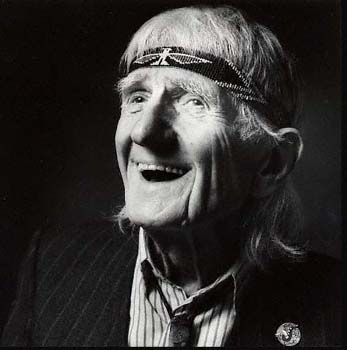| B i o g r a p h y |
 Green, Ian Ernest Gilmore (1912-1988) Arranger, composer, pianist, and bandleader
Green, Ian Ernest Gilmore (1912-1988) Arranger, composer, pianist, and bandleader
A self-taught musician, Gil Evans led his own band in Stockton,
California, from 1933 to 1938. When the singer Skinnay Ennis then took
over the band, Evans stayed on as arranger. In 1941, he joined Claude
Thornhill's group in the same capacity, contributing in 1946-7 such
outstanding arrangements as Anthropology, Donna Lee, Yardbird Suite,
and Robbins' Nest. In these works and others of the same period, Evans
used two french horns and a tuba (in addition to the standard swing era
big-band instrumentation); this, along with a restrained vibrato in the
saxophones and brass, produced a rich, dark-textured, "cool" orchestral
sound, anticipated only by Duke Ellington and Eddie Sauter. Emphasizing
ensemble over improvised solo, Evans's scores for Thornhill were far
from being straightforward arrangements — they were in essence
"recompositions" and "orchestral improvisations" on the original
materials (for example, lines of Charlie Parker's popular songs and
classical works such as Mussorgsky's Pictures at an Exhibition).
From 1948 to 1950, Evans contributed prominently to Miles Davis'
nonet recordings for Capitol (later issued as the LP Birth of the
Cool). In his memorable scores Boplicity and Moon Dreams, Evans
captured the essential sound and texture of the Thornhill band with a
smaller ensemble. Oddly, his work for both Davis and Thornhill was
ignored by critics and jazz audiences alike. After a period of relative
obscurity, during which he worked in radio and television, Evans
returned to jazz with three notable albums, all written for and
featuring Davis: Miles Ahead (1957), Porgy and Bess (1959), and
Sketches of Spain (1960). In these, as well as New Bottle, Old Wine
(1958), Evans extended his earlier orchestral concepts to larger
instrumental forces (up to 20), often achieving a distinctive synthesis
of varied timbral mixtures in which opaque, almost cluster-like
voicings alternate with rich polyphonic textures, the whole being
couched in an advanced harmonic language.
From the early 1960s, Evans made several attempts to form permanent
orchestras, but these were unable to establish themselves, although
they occasionally produced such excellent recordings as The
Individualism of Gil Evans (1963-4), Blues in Orbit (1969-71), and
Priestess (1977). He also turned increasingly to composition, writing
such notable works as Flute Song, Las Vegas Tango, Proclamation,
Variations on The Misery, Anita's Dance, and (in collaboration with
Miles Davis) Hotel Me and General Assembly. Later Evans incorporated
electrified instruments (piano, bass guitar, synthesizer, etc.) into
his ensembles and tended to leave more space for solo improvisation in
his arrangements and compositions. This led to a considerable loosening
of his style in both form and texture compared with the more compact
structures and veiled sonorities of his earlier arrangements. Even so,
the temper of his work remained moody, poignant, and introverted, as
was reflected in his predilection for pieces in minor keys. Although he
was at first influenced by the middle-period works of Duke Ellington,
Evans developed a style wholly his own, memorable especially for its
richly chromatic, though always tonally oriented, harmonic language and
its seemingly inexhaustible variety of timbral blendings; no mere
coloristic effects, these are often the very substance of his art,
providing imaginative frameworks for his soloists in ways equaled in
the history of jazz only by Jelly Roll Morton, Ellington, and Mingus.
Even in his most elaborate scores Evans succeeded in preserving the
essential spontaneity and improvisatory nature of jazz, achieving a
rare symbiosis between composed and improvised elements.
The New Grove Dictionary of Jazz, Oxford University Press.
All rights reserved.